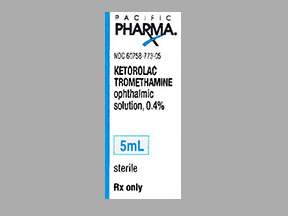
Acular Ls Coupons & Savings Card – Discount Prices from $25.24
Brand for: Ketorolac
My prescription
Edit
5ML of 0.4%, Ketorolac (1 Bottle)
Select pharmacy

CVS
$83.99
COUPON PRICE
Walgreens
$25.24
COUPON PRICE
Walmart
$54.01
COUPON PRICE
Albertsons
$58.60
COUPON PRICEAcular Ls savings card
Show this card to your pharmacist
Walgreens
$25.24
BIN
ID
PCN
GRP
011867
LH95A4DE06
HT
LABH001
Powered by
More prescriptions for pain
More prescriptions for pain
Price history for Acular Ls (brand) & Ketorolac (generic)
1 Bottle, 5ML of 0.4%
Average retail price for Acular Ls
Average retail price for Ketorolac
Average SaveHealth price for Ketorolac
Our price history data is based on aggregated prescription data collected from participating pharmacies in America. Our prescription data updates daily to reflect the latest price changes. If you notice a missing data point, it means there wasn't sufficient data available to generate a monetary value for that date.
Over the last 12 months, the average discount price of Acular Ls is $64.89 using the SaveHealth savings card. That's an average savings of 82.06% on Acular Ls with our discount card.
*Retail prices are based on pharmacy claims data, and may not be accurate when we don't have enough claims.
Acular Ls (Ketorolac) dosage forms
Dosage Quantity Price from Per unit 5ML of 0.4% 1 Bottle $54.01 $54.01 5ML of 0.4% 2 Bottles $105.52 $52.76 5ML of 0.4% 3 Bottles $163.54 $54.51
| Dosage | Quantity | Price from | Per unit |
|---|---|---|---|
| 5ML of 0.4% | 1 Bottle | $54.01 | $54.01 |
| 5ML of 0.4% | 2 Bottles | $105.52 | $52.76 |
| 5ML of 0.4% | 3 Bottles | $163.54 | $54.51 |
Acular Ls Warnings
The following safety information highlights potential risks and necessary precautions when using ketorolac eye drops. Please read carefully and consult your healthcare provider with any questions or concerns.
Delayed Healing: Ketorolac eye drops may slow the healing process, particularly if used alongside corticosteroid eye drops like prednisolone or dexamethasone. Regular follow-up appointments with your eye specialist are essential to monitor your healing progress.
Respiratory Concerns: Although rare, ketorolac eye drops may cause breathing difficulties or trigger asthma attacks, especially in individuals with a history of similar reactions to aspirin or other NSAIDs. Inform your healthcare provider if you have a history of breathing issues or allergies to these medications. Seek immediate medical attention if breathing problems occur after using ketorolac eye drops.
Increased Bleeding Risk: There is an elevated risk of bleeding post-eye surgery when using ketorolac eye drops. Notify your doctor if you have a history of bleeding disorders or are on medications like blood thinners that heighten bleeding risks. Contact your healthcare provider if you observe blood spots in your eye, particularly after surgery.
Corneal Issues: Ketorolac eye drops can cause corneal inflammation, weakening, or injury, potentially affecting vision. If you have a history of corneal problems, multiple eye surgeries, rheumatoid arthritis, or diabetes, inform your prescriber. Regular eye examinations are advised. Report any changes in vision or increased eye pain or discomfort to your eye care professional immediately. Use ketorolac eye drops strictly as prescribed and avoid prolonged use after surgery.
Contact Lens Advisory: Remove contact lenses before applying ketorolac eye drops. Consult your prescriber on when it is safe to reinsert them.
Please follow these guidelines closely to ensure safe and effective use of ketorolac eye drops.
Acular Ls Side Effects
When using this medication, you may notice some mild side effects, which are generally not a cause for concern. These include temporary stinging or burning sensations in the eyes, which can occur in up to 40% of users. Some individuals may also experience eye redness, swelling, or pain affecting up to 10% of users, as well as headaches. Other mild effects reported include higher eye pressure after cataract surgery, bleeding in the eye's outer membrane, blurry vision, tearing, and hazy or cloudy corneas. More moderate side effects that have been observed include swelling or inflammation of the cornea, inflammation of the iris, eye irritation, eye infections, and dry eyes. While these are less common, it's important to monitor their progression and consult your healthcare provider if they persist. On rare occasions, more serious side effects can occur, which require immediate medical attention. These include significant eye pain, swelling, or discharge, vision changes, and bleeding inside the eye. Additionally, although very rare, allergic reactions such as rash, itching, swelling of the face, tongue, or throat, severe dizziness, and difficulty breathing require urgent medical care. Always stay alert to any new symptoms and contact a healthcare provider if you have concerns.
Acular Ls Interactions
Ketorolac eye drops can interact with various medications and supplements. Inform your doctor and pharmacist about any medications or supplements you are taking, including prescriptions, over-the-counter drugs, vitamins, and herbal products.
Certain medications should generally not be used with Ketorolac due to potential interactions. These include numerous anti-inflammatory drugs such as Aceclofenac, Aspirin, Ibuprofen, Naproxen, and others. If your doctor prescribes these medications together, they may adjust the dosage or usage instructions.
Additionally, Ketorolac may increase the risk of bleeding when combined with other blood-thinning medications. This includes drugs like Clopidogrel, Warfarin, Dabigatran, Enoxaparin, and others. If you are using any of these, your healthcare provider may need to modify your treatment plan.
Remember to check all medication labels for pain relievers or fever reducers, as many contain ingredients similar to Ketorolac, which could heighten side effects. If your doctor has advised you to take low-dose aspirin to prevent heart attacks or strokes, continue to do so unless instructed otherwise. Always seek advice from your healthcare provider for more detailed information.
What is Acular LS used for?
Acular LS is used to relieve eye itching caused by seasonal allergies and to reduce inflammation and pain following eye surgery. It is a nonsteroidal anti-inflammatory drug (NSAID) in the form of eye drops.
What do ketorolac drops do for your eyes?
Ketorolac eye drops are used to relieve eye pain, irritation, and inflammation. They are often prescribed after eye surgeries or procedures to help reduce discomfort and swelling. Additionally, they can be used to alleviate symptoms associated with seasonal allergies affecting the eyes.
Is Acular LS a steroid?
Acular LS is not a steroid. It is a non-steroidal anti-inflammatory drug (NSAID) used to relieve eye itching and inflammation.
Are ACULAR eye drops an antibiotic?
ACULAR eye drops are not an antibiotic. They contain ketorolac tromethamine, which is a nonsteroidal anti-inflammatory drug (NSAID) used to relieve eye itching and inflammation.
Are ketorolac and ACULAR the same?
Yes, ketorolac and ACULAR are related. Ketorolac is the active ingredient in ACULAR, which is a brand name for the ophthalmic solution used to relieve eye itching caused by seasonal allergies.
